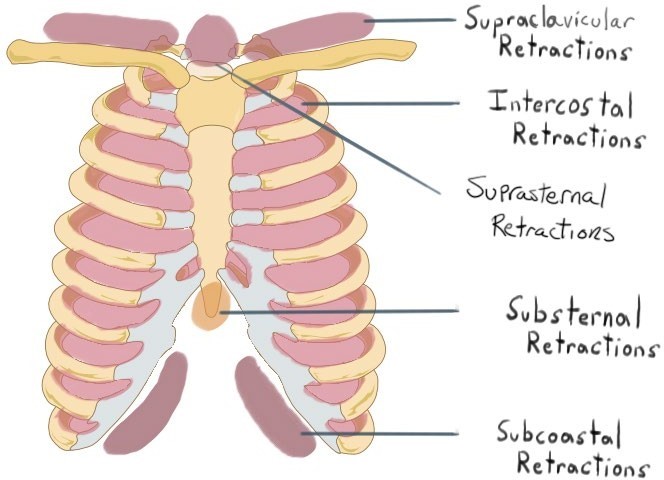A nurse is assessing a client who has postoperative atelectasis and is hypoxic. Which of the following manifestations should the nurse expect?
Lethargy
Bradycardia
Intercostal retractions
Bradypnea
The Correct Answer is C
Intercostal retractions, or the inward movement of the chest wall between the ribs, are a sign of respiratory distress and hypoxia. They indicate increased work of breathing and reduced lung expansion, which are common in clients who have postoperative atelectasis. Atelectasis is a collapse of alveoli in a part of the lung, which impairs gas exchange and oxygenation.
a) Lethargy, or a state of reduced mental alertness and energy, is not a typical manifestation of hypoxia. It can be caused by other factors, such as pain, medication, infection, or electrolyte imbalance. Hypoxia usually causes restlessness, anxiety, or confusion.
b) Bradycardia, or a slow heart rate, is not a typical manifestation of hypoxia. It can be caused by other factors, such as medication, vagal stimulation, or heart block. Hypoxia usually causes tachycardia, or a fast heart rate, as the body tries to compensate for the low oxygen level.
d) Bradypnea, or a slow respiratory rate, is not a typical manifestation of hypoxia. It can be caused by other factors, such as medication, brain injury, or metabolic alkalosis. Hypoxia usually causes tachypnea, or a fast respiratory rate, as the body tries to increase oxygen intake and carbon dioxide elimination.

Nursing Test Bank
Naxlex Comprehensive Predictor Exams
Related Questions
Correct Answer is ["A","C","E"]
Explanation
These clients have impaired swallowing, gag reflex, or level of consciousness, which increase their risk of aspiration while eating.
The other options are not correct because:
b. A client who has had prolonged diarrhea does not have a direct risk factor for aspiration, as diarrhea affects the lower gastrointestinal tract and not the upper airway or esophagus.
d. A client who has lactose intolerance does not have a risk factor for aspiration, as lactose intolerance causes abdominal cramps, bloating, gas, or diarrhea when consuming dairy products, but does not affect the ability to swallow or protect the airway.
Correct Answer is ["A","B","D"]
Explanation
Answer: A, B D
Rationale:
-
Albuterol is a bronchodilator, and one of its key effects is to relax the muscles around the airways, which helps prevent wheezing. Wheezing is often caused by narrowed airways, and by opening them, albuterol helps to prevent this sound, which is associated with asthma or other respiratory conditions.
-
B. The medication will decrease coughing episodes:
Albuterol can help decrease coughing in individuals with conditions like asthma or chronic obstructive pulmonary disease (COPD) by relaxing the muscles in the airways, which reduces airway constriction. Since coughing often occurs due to airway obstruction, albuterol’s bronchodilator effect can help alleviate this symptom. -
C. The medication will reduce inflammation: Albuterol does not have anti-inflammatory properties. Its primary mechanism is bronchodilation, and anti-inflammatory treatment generally requires corticosteroids, not beta-agonists like albuterol.
-
D. The medication will open the airways:
This is correct. Albuterol works as a bronchodilator, meaning it opens up the airways by relaxing the smooth muscles surrounding them. This improves airflow and makes breathing easier, which is why it is often used in conditions like asthma or COPD. -
E. The medication will stimulate flow of mucus: Albuterol does not stimulate mucus production; it primarily works by relaxing the airways. However, by improving airflow, it can help clients more effectively expel mucus through coughing.
Whether you are a student looking to ace your exams or a practicing nurse seeking to enhance your expertise , our nursing education contents will empower you with the confidence and competence to make a difference in the lives of patients and become a respected leader in the healthcare field.
Visit Naxlex, invest in your future and unlock endless possibilities with our unparalleled nursing education contents today
Report Wrong Answer on the Current Question
Do you disagree with the answer? If yes, what is your expected answer? Explain.
Kindly be descriptive with the issue you are facing.
